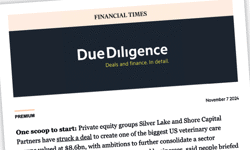The continuing economic downturn is having a significant but hopefully not devastating impact on much of the UK publishing industry’s capacity to invest for the future – especially in digital development where the immediate ROI benefits tend to be the least predictable and therefore the hardest to justify. But when the going gets tough...
The doldrums in which many companies are currently adrift present publishers with an ideal opportunity to stand back and assure themselves that they have covered all their digital bases. There will never be a better time to utilise any downtime in the new media department or to guarantee that your online operations are in full working order – and have the competitive edge to capitalise on the upturn when it comes, as it most surely will. What follows is a far from comprehensive list of the digital boxes that publishers should be looking to tick.
1. Specialist search
While Google has undoubtedly been one of the success stories of the last decade, its ubiquitous search engine has two key limitations – the accuracy, depth and relevance of its search results are only as good as the tagging and the taxonomy of the websites it is pointed at – and it only searches when spoken to.
For publishers whose key assets are either their customer or information databases (or both), the speed and power of the search technology industry that Google has spawned has opened up two new potential revenue streams - vertical search services supported by classified advertising revenue; and subscription-based online information monitoring.
Specialist or vertical search is shorthand for dynamically restructured directory databases supported by Yellow Pages-style enhanced listing and page ranking revenue. They are essentially online versions of traditional print directories and are exclusively directed at a publisher’s proprietary databases and rely on advertising for their revenue streams. Yell.com and Kellysearch.com are two of the UK’s largest such sites although several smaller publishers have also converted their print directory operations into online offerings.
According to a report by the search company Convera, the global market for B2B vertical search had reached over $500m by the end of 2007. The report also calculated that as a rule of thumb, specialist search should account for 1-3% of a B2B publisher's revenues.
KPIs: Ensuring that the structure, the tagging and taxonomy of the databases reflect customer needs is critical to success, but there are two other important variables that can make or break an online directory service in the eyes of advertisers and sponsors. These are, not surprisingly, the levels of traffic and the clarity of the offering – but there is a twist.
As in most other online advertising models, the number of unique visitors is the key to sustaining advertising yields at a commercially viable level but in the case of vertical search this is not just influenced by the size of the brand’s core readership or by investment in SEO and other forms of marketing; a major consideration for any publisher looking to invest in this form of vertical search has to be the range of services and products listed on the directory database. Without sufficient critical mass to generate enough interest from beyond a brand’s traditional reader base, publishers will struggle to offer either the traffic or enough enhanced entry and premium listing positions to turn a profit.
A way round this problem for smaller operators – both publishers and trade associations - lies in collaborative hubs, where companies in related and preferably overlapping sectors join forces to create that critical mass and to feed off each other’s traffic. For an example of how this can work, take a look at the applegate.co.uk site.
2 Online monitoring
One of the greatest challenges facing most business executives is how to filter the enormous amount of information now available at the click of a mouse via one of the major search engines. What they crave is relevant research and news updates delivered to their desktops as and when it becomes available.
Some of the first companies to recognise the gap in the market that this requirement for targeted and specialist information has presented were the traditional clipping services. These have transformed their newspaper cutting-to-photocopy-to-fax business models into a customised and frequently account-managed service where they deliver high-priced and highly targeted information packages (based on search criteria agreed with the client) to a customer’s PC and / or PDA via email, SMS or RSS feed.
KPIs: The key added value elements of such services are the relevance and comprehensiveness of the information they deliver; technologically speaking, this is determined by both the accuracy and underlying logic of the tagging of their internal databases and their search engine’s ability to web crawl or spider through external sites for any changes and updates in data and information.
While most mainstream publishers with information-rich archives have long since developed their business models for firewalling their proprietary databases, specialist online monitoring services generally come into their own when there is a large database of complex and constantly changing regulatory, legislative or technical information. As a result, competition is most fierce in the political publishing sector and several publishers in the medical publishing arena have attempted to corner a slice of their particular market, but with limited success. Transport and logistics also lends itself to this model because of the need for up-to-date information about shipping and other means of freight transport; but the market for publishers who service professional institutions and other trade bodies that have a mandate to keep their members up to speed with best practice, legislative and regulatory developments in their specific fields remains largely untapped.
3. B2B networking sites
At the latest count, well over 160 million people across the globe were using Facebook – a testament to a revolution in online consumer habits that shows no sign of abating. From a business publishing perspective, perhaps even more significant is the rapid growth in the number of over 35s who have signed up to the service; according to Inside Facebook, their ranks doubled in the first quarter of 2009. The implication of this is clear – social networking has long ceased to be a “youth” phenomenon and has entered mainstream – and therefore professional – patterns of behaviour. UGC – user-generated-content – is here to stay.
By definition, B2B networking sites aimed at finite groups of professionals can never hope to emulate the success of Facebook or even LinkedIn (28m registered users), but they can provide geographically disparate business communities of both decision makers and suppliers with an online environment where they can discuss common issues; share product information and expertise and strengthen existing relationships.
KPIs: Such B2B sites can only work if they are hosted by an independent third party such as a magazine publisher whose brand is already recognised and respected in a particular sector. They are in a position to kick-start membership by encouraging a core selection of specifiers and suppliers to sign up and in turn to invite their own colleagues and business contacts to participate. They can also conduct polls to instigate debates and provide panels of experts to answer FAQs as a means of traffic generation as well as offering a genuine service. The educational sector is in the vanguard of this movement - check out TES Connect from the Times Educational Supplement and the Key.
In the medium term, such sites are likely to be a standard CRM tool for increasing customer retention and strengthening brand loyalty and the ROI will probably come from a reduction in the cost of customer acquisition and a growth in advertising yields. In the short term, however, revenue is most likely to come from site sponsorship, where the yield is driven by the quality rather than the volume of traffic, and by the level of user participation and by sales of added-value services such as webinars and e-learning.
4. E-learning
In any economic downturn, training and marketing budgets are among the first to be cut, but the current EU and UK regulatory environments mean that companies still have to meet their mandatory compliance needs. E-learning is the cheapest and most efficient means of delivering compliance training as it involves minimum disruption and guarantees consistency of message. This presents publishers in the B2B sector with the opportunity to repackage and offer “own-brand”, sector-specific e-learning programmes to their customers, suppliers and other stakeholders.
KPIs: This is a relatively low-risk proposition as demand can be tested among existing readers at minimal costs. All a publisher needs to have for a fighting chance of success is enough readers from companies with common compliance training needs, some industry experts and a good e-learning partner.
On the horizon
Commercially web-based applications are being developed and adopted, but also discarded, at a frenetic pace and now is clearly not the time to take too many risks. Nevertheless, here are a couple of ideas you may hear more about in the coming months, either from your clients, customers or competitors and may be worth a brainstorm or two.
* Mash-ups. Web pages or applications that combine data and functionality from two or more external sources to create a new service are nothing new to the digerati but they reached a new level of general accessibility earlier this year when the Guardian launched its Open Platform, including the Data Store, which gives anybody who wants it access to and ability to process the hard data behind the headlines – from school admission figures to world carbon emission figures by country to “1,000 songs to hear before you die”. Potentially both a valuable viral marketing tool and a means of increasing reader involvement.
* Yammer. Yammer is essentially a firewalled version of Twitter, limited to participants who have an approved email address. Like Twitter, the length of each message is proscribed. Some publisher soon will come up with some clever way of offering this service to its subscribers.










